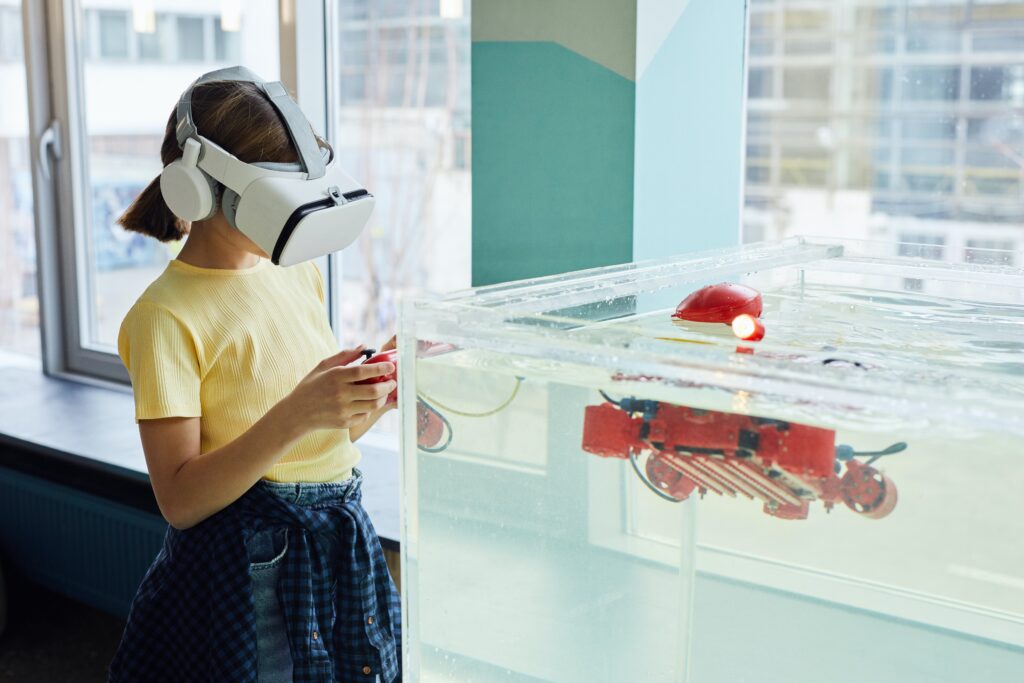Meta Lowers Minimum Age for Quest Headsets: A Controversial Move by Mark Zuckerberg
Mark Zuckerburg is at it again! A major update to Facebook’s VR platform has been unveiled by its parent company, Meta. Meta has chosen to drop the minimum age for its famous Quest headset from 13 to 10 years old, a move that is guaranteed to provoke debate and criticism. Get those pitchforks sharpened folks! This choice is timely since lawmakers and regulators have been putting pressure on digital firms to ensure the safety of minors using their services.
Parental Approval Required: Meta’s Safety Measures for Kid’s Accounts on Quest Headsets
Meta spokesperson Joe Osborne acknowledged the move to lower the minimum age requirement for the Quest headsets, saying that parents will need to approve the formation of a kid’s account for children aged 10 to 12. Meta has also informed the public that it will not serve targeted advertisements to people under the age of 18. In addition, a child’s Meta profile and avatar will be set to private by default, preventing strangers from following them until they give their permission.
Legal Pressures on Tech Companies: Congress Pushes for Stricter Regulations on Underage Users
Meta’s decision comes at a time when there is a flurry of new laws and regulations in place to safeguard children’s internet activities. There have been a number of measures presented in the United States Congress that would increase the authority of regulators and/or prohibit users under the age of 13 from using social media sites. Meta’s move to lower the minimum age for its VR headsets may appear paradoxical in light of the growing support for such suggestions.
Finding a Balance: Meta’s Decision to Lower the Minimum Age for Quest Headsets
Nonetheless, Meta has some valid reasons for taking this action. Because the firm knows that younger customers are eager to learn about and experiment with virtual reality technology, it has decided to drop the minimum age limit. Meta seeks to find a middle ground between meeting the needs of its younger users and protecting their safety by obtaining parental consent and incorporating safety mechanisms. It makes sense that if younger kids are going to use it anyway, then acknowledging that and putting safeguards in place makes a lot of sense.

Mental Health Concerns: Examining the Potential Impact of VR on Children
The possible influence of virtual reality and immersive technologies on children’s mental health and development is a major issue voiced by detractors. There is evidence that children’s brains can be negatively impacted by too much time spent in front of screens or by exposure to specific sorts of information. This worry applies to virtual reality (VR) encounters because of the potential for reality-virtual reality blending. Meta’s decision to make VR available to customers as young as 10 raises questions about the company’s approach to safety.
Ensuring Safety: Meta’s Safeguards and Parental Controls for Young Quest Users
Meta has addressed these worries by outlining a set of safeguards and parental controls that will be implemented alongside the reduced age limit. Parents may monitor their children’s use of the Quest headsets and even mandate breaks. This setting is essential for preventing kids from spending too much time in virtual worlds. Meta will also suggest apps that are appropriate for children of specific ages, limiting their exposure to inappropriate material.
Privacy and Security: Meta’s Measures to Protect Children’s Data
Meta has also made considerations for the privacy and security of user data. Children in the 10–12 age range will have their profiles and avatars set to private by default, so that no one may see their content unless they give their permission. This safeguard is in place to prevent youngsters from coming into contact with any undesirable parties when using the internet. Concerns about data collecting and commercial exploitation can be allayed because Meta will not show tailored adverts to these young users.
Challenges and Criticisms: Debating the Decision to Lower the Minimum Age for VR
Some may regard Meta’s decision to decrease the minimum age for its VR headsets as a positive development, but it’s vital to be aware of the potential difficulties and critiques that could arise as a result. Concerns regarding the long-term effects of VR on children’s well-being and the need for strict restrictions to protect their interests have been voiced by lawmakers and child advocacy groups. It has been argued that there is no foolproof way to protect youngsters from harm when using virtual reality headsets.
The Great Debate: Positive and Negative Perspectives on Children’s VR Usage
The age at which children should be allowed to use virtual reality and other forms of cutting-edge technology is a contentious topic of discussion. Proponents of this view say that children’s use of such gadgets has positive effects on their brain development and creativity. They argue that children can benefit from using these devices under adult supervision, especially if they are exposed to content that is both instructive and appropriate for their age.
Skeptics, on the other hand, are concerned about issues like addiction, desensitization, and stunted social and emotional growth. Ultimately, if you are a parent, then the decision lies with you. Perhaps some of our pro tips can help you make a more informed decision for the younger generation.

Pro Tips
Here are some helpful hints for parents as they explore this new terrain:
Learn About the Tools: Spend some time learning about virtual reality and how it can affect kids. Find out what to expect and how to get the most out of it.
Limit the amount of time spent in VR, ensure that it is only used for suitable purposes, and take all necessary safety measures. Explain these guidelines to your kid and make sure they comprehend why they’re in place.
Take into account your child’s age and degree of maturity before granting them access to virtual reality. Younger children may not be able to process all of the information presented in virtual environments.
Control Is Essential: Keep an eye on your kid when they’re using virtual reality. This will let you keep an eye on them, talk to them about their experiences, and make sure they’re safe.
Make time for exercise and genuine conversation a top priority: Try to get your kid out of the house and involved in real-life activities and social interactions as often as possible. Encourage a well-rounded upbringing by balancing their virtual reality time with real-world activities.
Before letting your child download or use any virtual reality apps or games, make sure you read the reviews and check the ratings beforehand. Find material that is suitable for your child’s age and interests them.
Encourage honest discussion regarding your child’s virtual reality (VR) experiences. Let them know that they can talk to you about any problems or worries they have with the technology. Make yourself available to address their concerns and queries.
Knowledge is power, so make sure you’re up-to-date on the newest studies, suggestions, and guidelines regarding VR use with kids. Always be aware of the latest threats and technological safeguards available.
Your child can have a positive and safe virtual reality experience if you follow these guidelines and continue to be involved in their exploration of the medium. Keep in mind that you play a key role as a guide and supervisor of their use of technology.
Conclusion
Meta will continue to be scrutinized by legislators, child advocacy groups, and concerned parents as it implements its plan to decrease the minimum age for its Quest headgear. The corporation needs to show it cares about user safety by addressing concerns parents may have about their children using virtual reality. Meta’s goal is to provide a service that can satisfy the needs of its younger users while also protecting their safety and privacy online by including features like age-appropriate content recommendations, parental controls, and other safeguards.






